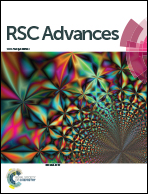Direct photoelectrochemical oxidation of hydroxymethylfurfural on tungsten trioxide photoanodes†
Abstract
An important target reaction for solar-powered biomass valorization is the conversion of 2,5-hydroxymethylfurfural (HMF) into key monomers for polyester production. Herein, photoanodes of WO3 are demonstrated to directly photo-oxidize HMF in aqueous electrolyte (pH 4) under simulated solar illumination. The addition of 5 mM HMF increases the saturation photocurrent by 26% and suppresses the water oxidation reaction, as determined by rotating ring-disk electrode experiments. Prolonged photoelectrochemical oxidation (64 h) illustrates system robustness and confirms the production of furandicarboxaldehyde (DFF), furandicarboxylic acid (FDCA), and related intermediates. Quantification of the reaction rate constants via a kinetic model gives insight into the modest DFF and FDCA yields (up to 4% and 1%, respectively)—which is due to the formation of by-products—and suggests routes for improvement.



 Please wait while we load your content...
Please wait while we load your content...